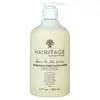What's inside
What's inside
 Key Ingredients
Key Ingredients

 Benefits
Benefits

 Concerns
Concerns

No concerns
 Ingredients Side-by-side
Ingredients Side-by-side

Water
Skin ConditioningSodium Lauroyl Methyl Isethionate
CleansingCocamidopropylamine Oxide
CleansingGlycerin
HumectantAcrylates Copolymer
Glycol Distearate
EmollientTrisodium Ethylenediamine Disuccinate
C13-15 Alkane
SolventGuar Hydroxypropyltrimonium Chloride
Skin ConditioningPolyquaternium-7
Bisabolol
MaskingCitric Acid
BufferingDisodium EDTA
Phenoxyethanol
PreservativeEthylhexylglycerin
Skin ConditioningAminomethyl Propanol
BufferingSodium Hydroxide
BufferingTocopherol
AntioxidantSodium Benzoate
MaskingWater, Sodium Lauroyl Methyl Isethionate, Cocamidopropylamine Oxide, Glycerin, Acrylates Copolymer, Glycol Distearate, Trisodium Ethylenediamine Disuccinate, C13-15 Alkane, Guar Hydroxypropyltrimonium Chloride, Polyquaternium-7, Bisabolol, Citric Acid, Disodium EDTA, Phenoxyethanol, Ethylhexylglycerin, Aminomethyl Propanol, Sodium Hydroxide, Tocopherol, Sodium Benzoate
Water
Skin ConditioningCetyl Alcohol
EmollientCetearyl Alcohol
EmollientBehentrimonium Chloride
PreservativeIsopropyl Palmitate
EmollientGlycerin
HumectantMyristyl Alcohol
EmollientHydroxyethylcellulose
Emulsion StabilisingSodium Dehydroacetate
PreservativeSodium Benzoate
MaskingIsopropyl Alcohol
SolventSorbitol
HumectantEthylhexylglycerin
Skin ConditioningCitric Acid
BufferingDisodium EDTA
Chlorhexidine Dihydrochloride
AntimicrobialNeopentyl Glycol Diheptanoate
EmollientIsododecane
EmollientHelianthus Annuus Seed Oil
EmollientTocopheryl Acetate
AntioxidantChamomilla Recutita Flower Extract
MaskingWater, Cetyl Alcohol, Cetearyl Alcohol, Behentrimonium Chloride, Isopropyl Palmitate, Glycerin, Myristyl Alcohol, Hydroxyethylcellulose, Sodium Dehydroacetate, Sodium Benzoate, Isopropyl Alcohol, Sorbitol, Ethylhexylglycerin, Citric Acid, Disodium EDTA, Chlorhexidine Dihydrochloride, Neopentyl Glycol Diheptanoate, Isododecane, Helianthus Annuus Seed Oil, Tocopheryl Acetate, Chamomilla Recutita Flower Extract
 Reviews
Reviews

Ingredients Explained
These ingredients are found in both products.
Ingredients higher up in an ingredient list are typically present in a larger amount.
Citric Acid is an alpha hydroxy acid (AHA) naturally found in citrus fruits like oranges, lemons, and limes.
Like other AHAs, citric acid can exfoliate skin by breaking down the bonds that hold dead skin cells together. This helps reveal smoother and brighter skin underneath.
However, this exfoliating effect only happens at high concentrations (20%) which can be hard to find in cosmetic products.
Due to this, citric acid is usually included in small amounts as a pH adjuster. This helps keep products slightly more acidic and compatible with skin's natural pH.
In skincare formulas, citric acid can:
While it can provide some skin benefits, research shows lactic acid and glycolic acid are generally more effective and less irritating exfoliants.
Most citric acid used in skincare today is made by fermenting sugars (usually from molasses). This synthetic version is identical to the natural citrus form but easier to stabilize and use in formulations.
Read more about some other popular AHA's here:
Learn more about Citric AcidDisodium EDTA plays a role in making products more stable by aiding other preservatives.
It is a chelating agent, meaning it neutralizes metal ions that may be found in a product.
Disodium EDTA is a salt of edetic acid and is found to be safe in cosmetic ingredients.
Learn more about Disodium EDTAEthylhexylglycerin (we can't pronounce this either) is commonly used as a preservative and skin softener. It is derived from glyceryl.
You might see Ethylhexylglycerin often paired with other preservatives such as phenoxyethanol. Ethylhexylglycerin has been found to increase the effectiveness of these other preservatives.
Glycerin is already naturally found in your skin. It helps moisturize and protect your skin.
A study from 2016 found glycerin to be more effective as a humectant than AHAs and hyaluronic acid.
As a humectant, it helps the skin stay hydrated by pulling moisture to your skin. The low molecular weight of glycerin allows it to pull moisture into the deeper layers of your skin.
Hydrated skin improves your skin barrier; Your skin barrier helps protect against irritants and bacteria.
Glycerin has also been found to have antimicrobial and antiviral properties. Due to these properties, glycerin is often used in wound and burn treatments.
In cosmetics, glycerin is usually derived from plants such as soybean or palm. However, it can also be sourced from animals, such as tallow or animal fat.
This ingredient is organic, colorless, odorless, and non-toxic.
Glycerin is the name for this ingredient in American English. British English uses Glycerol/Glycerine.
Learn more about GlycerinSodium Benzoate is a preservative. It's used in both cosmetic and food products to inhibit the growth of mold and bacteria. It is typically produced synthetically.
Both the US FDA and EU Health Committee have approved the use of sodium benzoate. In the US, levels of 0.1% (of the total product) are allowed.
Sodium benzoate works as a preservative by inhibiting the growth of bacteria inside of cells. It prevents the cell from fermenting a type of sugar using an enzyme called phosphofructokinase.
It is the salt of benzoic acid. Foods containing sodium benzoate include soda, salad dressings, condiments, fruit juices, wines, and snack foods.
Studies for using ascorbic acid and sodium benzoate in cosmetics are lacking, especially in skincare routines with multiple steps.
We always recommend speaking with a professional, such as a dermatologist, if you have any concerns.
Learn more about Sodium BenzoateWater. It's the most common cosmetic ingredient of all. You'll usually see it at the top of ingredient lists, meaning that it makes up the largest part of the product.
So why is it so popular? Water most often acts as a solvent - this means that it helps dissolve other ingredients into the formulation.
You'll also recognize water as that liquid we all need to stay alive. If you see this, drink a glass of water. Stay hydrated!
Learn more about Water